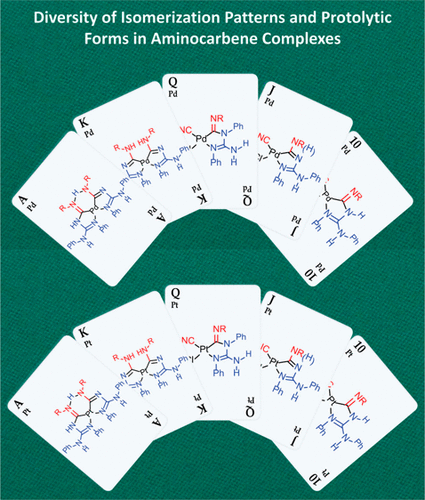当前位置:
X-MOL 学术
›
Organometallics
›
论文详情
Our official English website, www.x-mol.net, welcomes your feedback! (Note: you will need to create a separate account there.)
Diversity of Isomerization Patterns and Protolytic Forms in Aminocarbene PdII and PtII Complexes Formed upon Addition of N,N′-Diphenylguanidine to Metal-Activated Isocyanides
Organometallics ( IF 2.8 ) Pub Date : 2017-10-13 00:00:00 , DOI: 10.1021/acs.organomet.7b00569 Svetlana A. Katkova 1 , Mikhail A. Kinzhalov 1 , Peter M. Tolstoy 1 , Alexander S. Novikov 1 , Vadim P. Boyarskiy 1 , Anastasiia Yu. Ananyan 2 , Pavel V. Gushchin 1 , Matti Haukka 3 , Andrey A. Zolotarev 1 , Alexander Yu. Ivanov 1 , Semen S. Zlotsky 4 , Vadim Yu. Kukushkin 1, 2
Organometallics ( IF 2.8 ) Pub Date : 2017-10-13 00:00:00 , DOI: 10.1021/acs.organomet.7b00569 Svetlana A. Katkova 1 , Mikhail A. Kinzhalov 1 , Peter M. Tolstoy 1 , Alexander S. Novikov 1 , Vadim P. Boyarskiy 1 , Anastasiia Yu. Ananyan 2 , Pavel V. Gushchin 1 , Matti Haukka 3 , Andrey A. Zolotarev 1 , Alexander Yu. Ivanov 1 , Semen S. Zlotsky 4 , Vadim Yu. Kukushkin 1, 2
Affiliation

|
Reaction of the palladium(II) and platinum(II) isocyanide complexes cis-[MCl2(CNR)2] [M = Pd, R = C6H3(2,6-Me2) (Xyl), 2-Cl-6-MeC6H3, cyclohexyl (Cy), t-Bu, C(Me)2CH2(Me)3 (1,1,3,3-tetramethylbuth-1-yl abbreviated as tmbu); M = Pt, R = Xyl, 2-Cl-6-MeC6H3, Cy, t-Bu, and tmbu] with N,N′-diphenylguanidine (DPG) leads to DPG-derived metal-bound deprotonated acyclic diaminocarbene (ADC) species. This reaction occurs via a two-step process, involving the initial coupling of the guanidine with one of the isocyanides and leading to deprotonated monocarbene monochelated species, while the next addition grants the deprotonated bis-carbene bis-chelated metal compounds. DPG behaves as nucleophile, deprotonating base, and chelator. The addition of DPG proceeded with different regioselectivity depending on the metal center and, in a larger extent, on the substituent R in RNCs. The X-ray diffraction studies for the deprotonated mono- and bis-carbene complexes confirmed the regioisomerism of these species and allowed the identification of ADC protolytic forms stabilized in the solid-state. 1D (1H and 13C{1H}) and 2D (1H,1H-NOESY; 1H,15N-HSQC; 1H,15N-HMBC) solution NMR of the obtained systems demonstrated their configuration isomerism accompanied by prototropic tautomerism. Together, the solid-state and solution data provide an insight into the flexible character of ADC species.
中文翻译:

N,N'-二苯基胍与金属活化的异氰酸酯加成后形成的氨基卡宾Pd II和Pt II配合物中异构化模式和蛋白水解形式的多样性
钯(II)和铂(II)异氰化物配合物的反应顺式-[MCl 2(CNR)2 ] [M = Pd,R = C 6 H 3(2,6-Me 2)(Xyl),2-Cl -6-MeC 6 H 3,环己基(Cy),t- Bu,C(Me)2 CH 2(Me)3(1,1,3,3-四甲基丁-1-基缩写为tmbu);M = Pt,R = Xyl,2-Cl-6-MeC 6 H 3,Cy,t- Bu和tmbu],其中N,N'-二苯基胍(DPG)导致DPG衍生的金属结合的去质子化的无环二氨基卡宾(ADC)物种。该反应通过两步过程进行,包括将胍与一种异氰酸酯进行初始偶联,并导致去质子化的单卡宾单螯合物质,而下一次添加则得到去质子化的双卡宾双螯合金属化合物。DPG表现为亲核试剂,去质子化碱基和螯合剂。DPG的添加以不同的区域选择性进行,这取决于金属中心,并且在更大程度上取决于RNC中的取代基R。对去质子化的单-和双-卡宾配合物的X射线衍射研究证实了这些物种的区域异构现象,并允许鉴定稳定在固态的ADC蛋白质水解形式。1D(1 H和所得系统的13 C { 1 H})和2D(1 H,1 H-NOESY;1 H,15 N-HSQC;1 H,15 N-HMBC)溶液NMR证实了它们的构型异构现象伴随质子互变异构现象。固态数据和解决方案数据一起提供了对ADC种类的灵活特性的深入了解。
更新日期:2017-10-14
中文翻译:

N,N'-二苯基胍与金属活化的异氰酸酯加成后形成的氨基卡宾Pd II和Pt II配合物中异构化模式和蛋白水解形式的多样性
钯(II)和铂(II)异氰化物配合物的反应顺式-[MCl 2(CNR)2 ] [M = Pd,R = C 6 H 3(2,6-Me 2)(Xyl),2-Cl -6-MeC 6 H 3,环己基(Cy),t- Bu,C(Me)2 CH 2(Me)3(1,1,3,3-四甲基丁-1-基缩写为tmbu);M = Pt,R = Xyl,2-Cl-6-MeC 6 H 3,Cy,t- Bu和tmbu],其中N,N'-二苯基胍(DPG)导致DPG衍生的金属结合的去质子化的无环二氨基卡宾(ADC)物种。该反应通过两步过程进行,包括将胍与一种异氰酸酯进行初始偶联,并导致去质子化的单卡宾单螯合物质,而下一次添加则得到去质子化的双卡宾双螯合金属化合物。DPG表现为亲核试剂,去质子化碱基和螯合剂。DPG的添加以不同的区域选择性进行,这取决于金属中心,并且在更大程度上取决于RNC中的取代基R。对去质子化的单-和双-卡宾配合物的X射线衍射研究证实了这些物种的区域异构现象,并允许鉴定稳定在固态的ADC蛋白质水解形式。1D(1 H和所得系统的13 C { 1 H})和2D(1 H,1 H-NOESY;1 H,15 N-HSQC;1 H,15 N-HMBC)溶液NMR证实了它们的构型异构现象伴随质子互变异构现象。固态数据和解决方案数据一起提供了对ADC种类的灵活特性的深入了解。



























 京公网安备 11010802027423号
京公网安备 11010802027423号